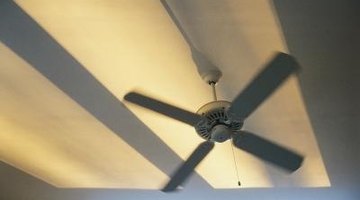Is It Dangerous to Leave Ceiling Fans on?
Coming home to a warm house is fine in the winter but not as much in the summer when you go indoors to get a break from the heat. Ceiling fans keep your home cool at a fraction of the cost of air conditioning, so you'll pay almost nothing to leave them on all day. Despite this, you should turn them off before you leave home.
What Happens

When you leave a ceiling fan running in an empty room, it continues spinning just as it did while you were in the room. You are as safe when you don't see the fan as it is when you do. Unlike a cooking appliance such as an oven, a fan does not require supervision.
Benefits
Ceiling fans make you feel cool, even when the temperature is not very cool inside your home. Ceiling fans don't actually lower the temperature in the room but give the illusion of a lower temperature by circulating air. For this reason, they work most effectively when you're actually in the room; they don't make the entire home feel cool the way an air conditioner does.
Cost
Electricity companies measure consumption in kilowatt-hours. A typical ceiling fan uses 65 to 175 watts of electricity, which equals 0.065 to 0.175 kilowatts. Since the U.S. Energy Information Administration reports the price of a kilowatt-hour at about 12 cents as of June 2011, a ceiling fan that uses 0.175 kW uses 2 cents worth of electricity every hour. Leaving one fan on for 24 hours costs less than 50 cents. By comparison, the cost is $4 to leave air conditioning on all day.
When It Is Dangerous
Since a ceiling fan is only as dangerous when you're gone as it is when you're home, a poorly installed ceiling fan may come loose from the ceiling while you're away, which is a hazard any time, so hire a professional to install your fan if you don't have experience installing ceiling fans.
References
Photo Credits
- Comstock/Comstock/Getty Images
More Articles



